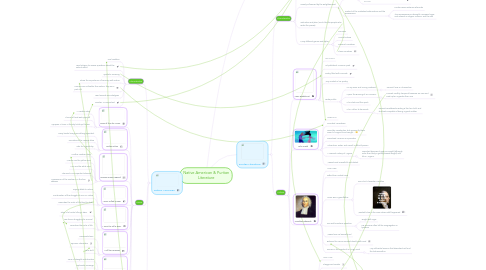
1. Native American
1.1. Characteristics
1.1.1. Oral Tradition
1.1.2. Used religion to answer questions about the natural world
1.1.3. Symbolic meaning
1.1.4. Stress the importance of harmony with nature
1.1.5. Humans are not better than nature, they are a part of it
1.1.6. Used animals as archetypes
1.1.7. Number 4 is important
1.2. Pieces
1.2.1. Song of the Sky Loom
1.2.1.1. A creation story
1.2.1.2. Theme of hard work pays off
1.2.1.3. Synopsis: a loom in the sky holds up the sun
1.2.2. Walam Olum
1.2.2.1. Every leader brings something important
1.2.2.2. Narrative of the Lenape tribe
1.2.2.3. Asks for a good day
1.2.3. Navajo Origin Legend
1.2.3.1. Another creation story
1.2.3.2. Women are the yellow corn
1.2.3.3. Men are the white corn
1.2.3.4. The wind is an important element
1.2.3.5. Appearance of the number 4 in the four seasons
1.2.4. I Have Killed a Deer
1.2.4.1. Paying debts to nature
1.2.4.2. Continuation of the struggle of man vs. nature
1.2.4.3. Describes the circle of life (dust to dust)
1.2.5. I Went to Kill a Deer
1.2.5.1. Story of a hunter killing a deer.
1.2.5.2. Two forces struggling for survival
1.2.5.3. Describes the circle of life
1.2.6. I Kill her Enemies
1.2.6.1. Passionate tone
1.2.6.2. Dynamic characters
1.2.6.3. Tone shift
1.2.7. Prayer at Sunrise
1.2.7.1. Tone of strength and devotion
1.2.7.2. Optimistic message
1.2.7.3. Speaks about harmony and unity
1.2.8. The World on A Turtle's Back
1.2.8.1. Creation story
1.2.8.2. Biblical allusions
1.2.8.3. Good vs. Evil
1.3. Authors
1.3.1. Due to oral traditions rather than written language, many stories have different variations that have been passed from tribe to tribe and from generation to generation.
2. William Bradford
2.1. 1590-1657
2.2. Created the term "Pilgrim"
2.3. Intended to arrive at Virginia, but ended up in Massachusetts
2.4. Elected as the governor of Plymouth
2.5. "Of Plymouth Plantation"
3. Puritan Literature
3.1. Characteristics
3.1.1. Speaks about religion
3.1.2. Heavily influenced by the Enlightenment
3.1.2.1. 1607-1800
3.1.2.1.1. 1607- founding of Jamestown, the first colony
3.1.2.1.2. 1800- American Revolution ended at Yorktown in 1781
3.1.2.2. Product of the Protestant Reformation and the Renaissance
3.1.2.2.1. Puritans were extreme reformists
3.1.2.2.2. The Renaissance Era brought a renewed vigor and interest in religion, science, and the arts
3.1.3. Instructive and plain (much like the people who wrote the pieces)
3.1.4. Many different genres and styles
3.1.4.1. Sermons
3.1.4.2. Journal entries
3.1.4.3. Personal narratives
3.1.4.4. Slave narratives
3.2. Authors
3.2.1. Anne Bradstreet
3.2.1.1. 1612-1672
3.2.1.2. 1st published American poet
3.2.1.3. Poetry filled with conceits
3.2.1.4. Very modest in her poetry
3.2.1.5. Quite prolific
3.2.1.5.1. "To my Dear and Loving Husband"
3.2.1.5.2. "Upon the Burning of our Houses"
3.2.1.5.3. "The Flesh and the Spirit"
3.2.1.5.4. "The Author to her Book"
3.2.2. John Smith
3.2.2.1. 1580-1631
3.2.2.2. Founded Jamestown
3.2.2.3. Saved by Pocahontas- but apparently there wasn't a magical love triangle.... :(
3.2.2.4. Described America as a paradise
3.2.2.5. Adventurer, writer, and overall a difficult person
3.2.2.6. A General History of Virginia
3.2.2.6.1. Important because it gave an insight (although more than likely a greatly biased insight) into life in Virginia.
3.2.2.7. Viewed God as wrathful and distant
3.2.3. Jonathan Edwards
3.2.3.1. 1703-1758
3.2.3.2. Talked less, smiled more
3.2.3.3. Aaron Burr's grandfather
3.2.3.3.1. Burr Shot Alexander Hamilton
3.2.3.3.2. Wanted to be in the room where stuff happened
3.2.3.4. Fire and brimstone preacher
3.2.3.4.1. Taught with vigor
3.2.3.4.2. His sermons often left his congregation in hysterics
3.2.3.5. Viewed man as basically evil
3.2.3.6. Believed he communicated directly with God
3.2.3.7. Sinners in the Hands of an Angry God
3.2.3.7.1. Very influential sermon that described Hell and the tortures within.
3.2.4. Edward Taylor
3.2.4.1. 1644-1729
3.2.4.2. Clergyman/minister
3.2.4.3. Poems were unheard of until 1930 when they were found in the Yale library
3.2.4.4. Wrote conceits in the style of metaphysical poetry
3.2.4.5. Examined inner self-communion with God
3.2.4.6. Meditated and wrote poetry on Saturday nights to prepare for Sunday sermons
3.2.4.7. Asked for help from God to glorify God
3.2.4.8. "Huswifery"
3.2.4.8.1. Conceit: He wanted to weave God's teachings into a holy, moral robe
3.2.4.9. "Upon a Spider Catching a Fly"
3.2.4.9.1. Conceit: Satan is a spider who spins his web to catch unsuspecting victims through sins. Only the Puritans (wasps) are strong enough to be freed through the grace of God.
